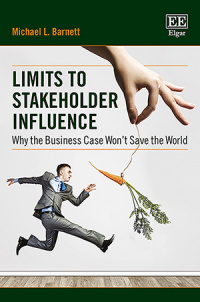Paperback
Limits to Stakeholder Influence
Why the Business Case Won''t Save the World
9781800371033 Edward Elgar Publishing
In business, does it pay to be good? Drawing from two decades of published conceptual and empirical scholarship, this book outlines the mechanisms of the business case for corporate social responsibility and demonstrates the conditions that cause good corporate acts to succeed, or fail, in turning a profit. Central to the explanation is the role of stakeholders, who are portrayed as agents who can turn corporate “good into gold” but lack the capacity to do so consistently. This book takes a critical perspective, noting significant limits on the ability of stakeholders to reward good corporate behavior and rein in bad corporate acts. It concludes with several ways that scholars can improve this important and popular research topic.
More Information
Contents
More Information
In business, does it pay to be good? Drawing from two decades of published conceptual and empirical scholarship, this book outlines the mechanisms of the business case for corporate social responsibility and demonstrates the conditions that cause good corporate acts to succeed, or fail, in turning a profit. Central to the explanation is the role of stakeholders, who are portrayed as agents who can turn corporate “good into gold” but lack the capacity to do so consistently. This book takes a critical perspective, noting significant limits on the ability of stakeholders to reward good corporate behavior and rein in bad corporate acts. It concludes with several ways that scholars can improve this important and popular research topic.
Using arguments built from two decades of highly cited and award-winning published scholarship, Michael L. Barnett uses strong theoretical building blocks and a well-vetted critical perspective to chart the boundaries of the business case for corporate social responsibility. The original introduction organizes and integrates this world-class research into a coherent and convincing story, while the original concluding chapter takes the reader beyond the current literature and provides a path forward that can build a better business case. A multifaceted mix of conceptual and empirical work across levels of analysis (individual, firm, and industry) provides a comprehensive perspective, warts and all.
This critical and approachable collection will be a key resource for management scholars, from doctoral students to senior professors, whether they seek to gain a foothold on the core topic of the relationship between business and society or wish to find a way to add to this rich literature. The book would fit as a resource in doctoral seminars and university libraries. Consulting firms and practitioners may also take interest, as they prepare for, and prepare others for, leadership roles in corporations.
Using arguments built from two decades of highly cited and award-winning published scholarship, Michael L. Barnett uses strong theoretical building blocks and a well-vetted critical perspective to chart the boundaries of the business case for corporate social responsibility. The original introduction organizes and integrates this world-class research into a coherent and convincing story, while the original concluding chapter takes the reader beyond the current literature and provides a path forward that can build a better business case. A multifaceted mix of conceptual and empirical work across levels of analysis (individual, firm, and industry) provides a comprehensive perspective, warts and all.
This critical and approachable collection will be a key resource for management scholars, from doctoral students to senior professors, whether they seek to gain a foothold on the core topic of the relationship between business and society or wish to find a way to add to this rich literature. The book would fit as a resource in doctoral seminars and university libraries. Consulting firms and practitioners may also take interest, as they prepare for, and prepare others for, leadership roles in corporations.
Contents
Contents: 1. The business case is a basket case: An introduction 2. C. J. Fombrun, N. A. Gardberg & M. L. Barnett. 2000. Opportunity platforms and safety nets: Corporate citizenship and reputational risk. Business and Society Review, 105(1): 85-106. 3. M. L. Barnett & R. M. Salomon. 2006. Beyond dichotomy: The curvilinear relationship between social responsibility and financial performance. Strategic Management Journal, 27(11): 1101-1122. 4. M. L. Barnett. 2007. Stakeholder influence capacity and the variability of financial returns to corporate social responsibility. Academy of Management Review, 32(3): 794-816. 5. M. L. Barnett & R. M. Salomon. 2012. Does it pay to be really good? Addressing the shape of the relationship between social and financial performance. Strategic Management Journal, 33: 1304-1320. 6. A. King, M. Lenox & M L. Barnett. 2002. Strategic responses to the reputation commons problem. In A. Hoffman and M. Ventresca (eds.), Organizations, Policy, and the Natural Environment: Institutional and Strategic Perspectives. Stanford, CA: Stanford University Press, 393-406. 7. M. L. Barnett & A. A. King. 2008. Good fences make good neighbors: A longitudinal analysis of an industry self-regulatory institution. Academy of Management Journal, 51(6): 1150-1170. 8. M. L. Barnett. 2006. Finding a working balance between competitive and communal strategy. Journal of Management Studies, 43(8): 1753-1773. 9. M. L. Barnett. 2013. One voice, but whose voice? Exploring what drives trade association activity. Business & Society, 52(2): 213-244. 10. M. L. Barnett. 2014. Why stakeholders ignore firm misconduct: A cognitive view. Journal of Management, 40(3): 676–702. 11. M. L. Barnett & S. Leih. 2018. Sorry to (not) burst your bubble: The influence of reputation rankings on perceptions of firms. Business & Society, 57(5): 962-978. 12. M. L. Barnett. 2019. The business case for corporate social responsibility: A critique and an indirect path forward. Business & Society. (in press; DOI: 10.1177/0007650316660044) 13. Building a better business case: Where do we go from here? Index




